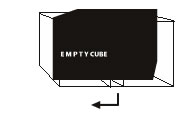MIGUEL PALMA
FEBRUARY, 10, 2010

CONTACTS
http://www.baginski.com.pt
EXHIBITION INFORMATION
MEMORABILIA
2010
Instalação
(auto)memorável
(auto)memorável draws inspiration from the automobile universe to create a moment of reflection on art and the creative process of its author, Miguel Palma.
Taking as his starting-point the cube’s empty space, Palma accepts the challenge of ephemerality, so intrinsic to the Empty Cube project, turning his intervention into a part of the memory of all those present.
Unquestionably, the automobile appears as the basic element of the exhibited project’s whole structure.
The many artefacts shown here chronologically display the automobile during its technical evolution, as an instance of visionary spirit and an effort towards expanding the limitations of the human body.
The impact the automobile has had ever since it appeared is undeniable. Thanks to this machine, Man has widened his range of action and changed the landscape and his occupation of space, along with his production and distribution of foodstuffs and other goods.
Palma adds himself to the huge and varied memorabilia exhibited here. At first sight, he is a collector, but he is also an author of projects and someone who plays an active part in History itself.
The excess of information exists as a counterpoint to the horror of absence – a fat to which Consumer Society has got us all used, and which stops us from considering a new social structure, free from profit-driven conflicts. Yet, at the same time Palma is sharing his M.O., something usually only those who work directly with him are familiar with.
References are made to subjects that are part of the problems affecting us all today: urbanism, energy, politics, war…
His pioneering spirit is also seen in his participation in car racing (Prova de Artista, 2001) or in the various journeys he carried out in “prototypes” of his own invention, or even in his rethinking of human bellicosity (Sementeira, 2006).
At the entrance to Appleton Square, even before they reach the inside of the Cube, visitors find themselves confronted with an installation (Memorabilia, 2010) that makes us think about the environmental consequences of using a car, which we tend to overlook in favour of our needs (be they real or artificially created). The poisonous gases from the exhaust pipe fill up a balloon, inside which they are filtered.
The artist’s attitude is one of purifying or sanctifying the machine. It is Man who pollutes, and it is him, too, who has the power to eliminate this negative side to the use of his invention. All problems can be solved, provided less clear criteria, such as economic viability, are not considered as variables in these problems.
Palma also reveals, though in a non-explicit way, his working process.
With the help of connoisseurs, the artist selects and gathers various automobile-related artefacts. It is these that, on a first approach, act as his eyes, fulfilling his desires.
This less-known aspect is essential to his creative process.
Then, Miguel Palma goes to his “workshop” (studio), where he will deconstruct, destroy, recreate and transform the objects (cars), conceiving new solutions or situations inspired by them. Palma reacts to the assembly-line’s automation by assuming the same approach as creators from the past, giving a new meaning to the machine’s functionality.
Thus, spectators are given the chance to take an inside part in this creative process, which the cube metaphorically divides, by coming to their own conclusions regarding their perception of the artist’s work.
Pedro dos Reis





